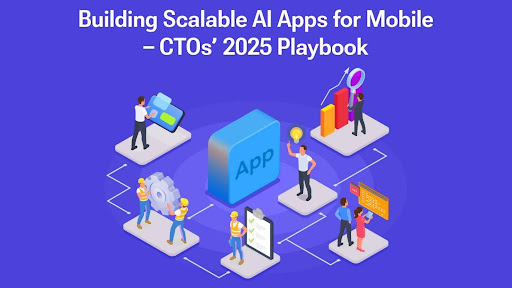
The AI wave is crashing into mobile at full force—and CTOs across industries are being called to ride it. From smart recommendations to predictive analytics, AI in mobile apps is transforming how businesses operate and how users interact with digital platforms.
To build scalable AI apps, CTOs must master the delicate balance between user experience, app performance, compliance, cost, and choosing the right AI development services.
Welcome to the CTO’s 2025 Playbook for building scalable, AI-driven mobile applications.
Why AI in Mobile Apps Is a Business Imperative
AI-powered features are no longer “nice to have”—they’re a key differentiator. Whether it’s voice assistants, real-time translation, smart image recognition, or hyper-personalized content feeds, AI-based mobile apps provide enhanced value and drive deeper user engagement.
CTOs are now challenged not only to adopt AI but to build AI apps for mobile that are robust, privacy-compliant, and scalable enough to handle dynamic user bases.
1. Begin with Scalable Mobile App Architecture
A solid mobile app architecture is the bedrock of every scalable, AI-powered app. As AI models become more complex and data-intensive, mobile app scalability demands a component-based, modular approach. Partnering with the right mobile app development services ensures these architecture principles are effectively implemented from the ground up.
Ideal Practices for Mobile App Architecture:
- Allows independent scaling and faster updates.
- Reduces latency for real-time AI inference.
- Keep your ML logic, business logic, and UI layers distinct.
- For dynamic resource allocation and model training.
These mobile app architecture best practices enable AI features to function efficiently without degrading overall mobile app performance.
2. Choose the Right AI Features That Scale
CTOs must be strategic in selecting AI capabilities that align with business goals and user behavior. Here are some scalable AI use cases gaining traction in 2025:
Predictive text and voice assistants
Real-time language translation
Computer vision for augmented reality
User behavior analytics for personalization
AI-powered fraud detection in fintech apps
Every feature you implement must go through a rigorous AI inference optimization process to ensure it scales under heavy usage and doesn’t affect mobile app performance optimization efforts.
3. Machine Learning in Mobile Apps
While cloud-based inference is cost-effective for complex tasks, edge AI enables faster responses and offline functionality.
Considerations for AI Application Deployment:
Latency tolerance: Tasks like object detection benefit from edge inference.
Model size & complexity: Heavier models require cloud offloading.
Cost management: Edge AI reduces cloud data transmission fees.
Security: On-device inference offers enhanced privacy.
A hybrid deployment strategy helps balance AI capabilities with performance and cost-efficiency.
4. Budgeting the Cost of Integrating AI in Mobile Apps
Estimating the cost of integrating AI in mobile apps is vital for long-term planning. AI integration is not a one-time expense—it involves:
Model development and training
Ongoing model tuning and retraining
Infrastructure and storage for datasets
Licensing third-party APIs or SDKs
Developer and data science resource allocation
While initial AI feature integration may cost between $15,000 to $50,000 depending on complexity, the long-term ROI in terms of improved user engagement and retention often outweighs the investment.
5. Focus on Mobile App Performance Optimization
AI can bog down app speed if not carefully implemented. CTOs must prioritize mobile app performance optimization to ensure a frictionless experience. Some strategies include:
AI inference optimization for faster results
Model compression techniques like quantization and pruning
Asynchronous processing to prevent UI lag
Battery consumption monitoring for AI tasks
Lazy loading of models only when required
Remember, even the smartest AI will fail if the app feels slow, buggy, or drains battery.
6. Overcoming User Experience Challenges
AI should enhance—not confuse—the user journey. Poorly executed AI features often lead to a spike in uninstalls or negative reviews. Here’s how to tackle user experience challenges in AI-driven mobile apps:
Explainable AI: Help users understand how recommendations or decisions are made.
Feedback loops: Let users fine-tune AI behavior (e.g., personalized suggestions).
A/B testing: Continuously experiment and refine AI features.
Inclusive UX: Avoid biases and design for accessibility.
UX and AI must work together to deliver relevance, trust, and control to end users.
7. Compliance: GDPR and CCPA Are Non-Negotiable
In 2025, data privacy isn’t optional—it’s mission-critical. Both GDPR compliance and CCPA compliance must be built into the design and functionality of any AI-powered mobile app.
Compliance Considerations for AI-Based Mobile Apps:
User consent: Obtain explicit consent for data collection and AI usage.
Data minimization: Collect only what is necessary for AI to work effectively.
Right to explanation: Users should know how AI decisions impact their actions.
Data deletion: Give users control over deleting stored data and AI records.
Falling short on compliance not only risks lawsuits but damages user trust—something no app can afford.
8. Build for Mobile App Scalability from Day One

A scalable AI solution is not just about infrastructure—it’s about future proofing. CTOs should architect systems that grow with user demand, support new AI models, and allow flexible integration.
How to Build Scalable AI Mobile Apps:
- API-first development for easier AI model upgrades
- Modular codebase to support plug-and-play AI features
- CI/CD pipelines that support retraining and deployment of ML models
By designing mobile app scalability, businesses ensure that today’s MVP won’t become tomorrow’s bottleneck.
9. Futureproofing with Continuous AI Optimization
AI isn’t a set-and-forget component. CTOs must invest in continuous learning systems to enhance AI functionality and accuracy over time.
- Model retraining: Using fresh data to avoid AI model drift.
- User feedback integration: Let AI learn from real interactions.
- Data annotation pipelines: To support supervised ML improvements.
- Usage pattern analysis: Understand where AI helps—or hinders—the user journey.
The goal is simple: keep evolving your AI features with app performance as user needs and data trends shift.
Conclusion: CTOs as Architects of Intelligent Mobile Futures
To build AI apps for mobile that scale, perform, and delight—CTOs in 2025 must step up as strategic leaders, not just tech decision-makers. The convergence of AI, privacy compliance, performance, and UX demands a comprehensive, future-ready approach.
Whether you’re planning to implement machine learning in mobile apps, solve user experience challenges, or address GDPR and CCPA compliance, the road to success begins with a scalable vision. Embrace mobile app architecture best practices, prioritize mobile app performance optimization, and stay committed to ethical, user-centric AI innovation.
The future belongs to those who not only build—but build scalable AI apps that empower users, deliver value, and stand the test of time.







